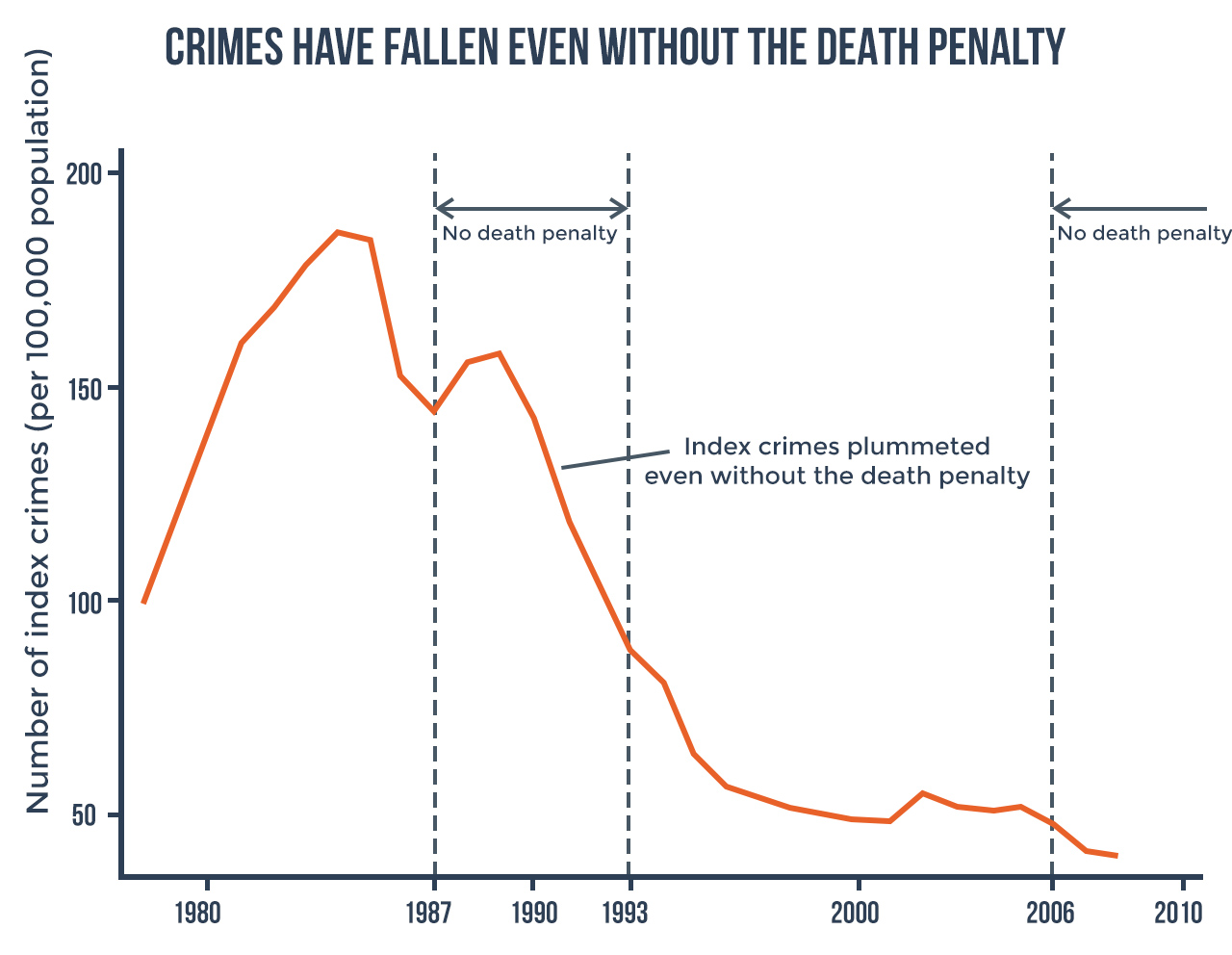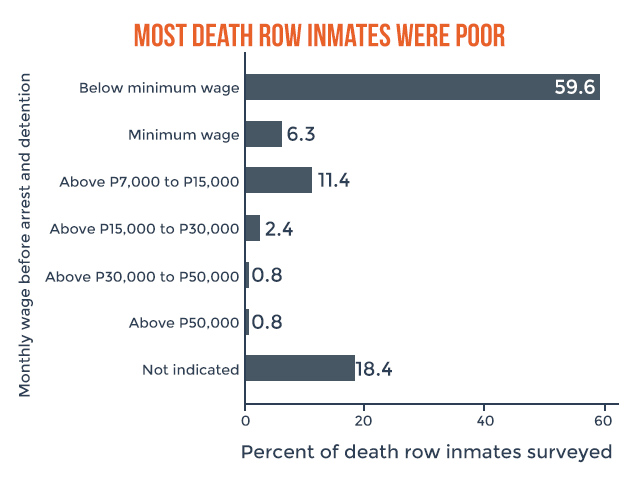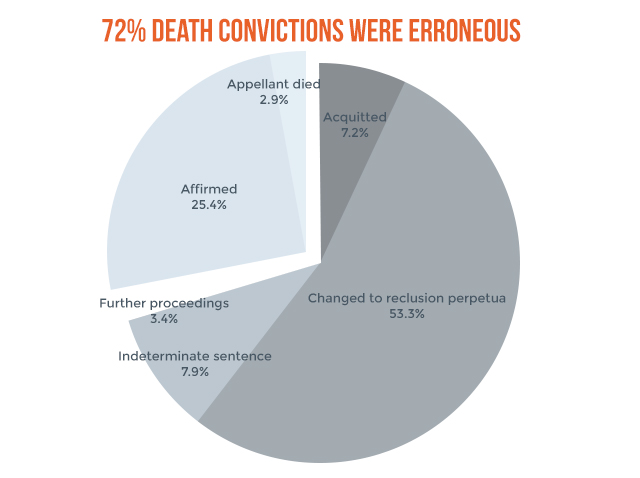
To address the country’s drug and crime problem, President Duterte has called on Congress to resurrect the death penalty after it was abolished in 2006.
In response, the House of Representatives Committee on Justice swiftly approved House Bill 1 last December, with plenary debates now ongoing. In the Senate, the death penalty bill is reportedly having a much harder time because of greater opposition from the senators. (READ: Senate poised to kill death penalty)
Indeed, there’s a great deal of debate surrounding the pros and cons of the death penalty. But in this article we take on the issue by turning to statistics, empirical studies, and a review of the country’s past experience with the death penalty.
All in all, the data suggest that the death penalty will be unnecessary, anti-poor, and error-prone given the current state of our legal and judicial system.

1) Crime rates have fallen even without the death penalty.
Many people justify the return of the death penalty because of its purported ability to quell the rising tide of criminality plaguing the country. The idea is that executing felons for committing heinous crimes will deter future criminals, thus lowering crime rates.
But Figure 1 shows that from 1978 to 2008 there had been a general decline in the incidence of “index crimes”. These are crimes that occur with “sufficient regularity” and have “socioeconomic significance”, including some “heinous” ones like murder and rape.

Crime data are usually laden with many caveats, most notably underreporting. But despite these limitations, Figure 1 suggests at least 3 things.
First, the supposed “rising tide” of criminality is more of a myth than a fact: index crimes have, in fact, been falling steadily since the early 1990s.
Second, even in the years without the death penalty, the index crime rate had plummeted. Hence, the death penalty is not necessary to see a fall in crime rates.
Third, even after a record number of executions in 1999 (when Leo Echegaray and 6 others were put to death by lethal injection), no pronounced drop in index crimes was observed. The incidence of index crimes even rose by 8.8% from 1999 to 2002.
2) Studies abroad could also not find strong evidence the death penalty deters crime.
Many other countries also fail to see compelling evidence the death penalty deters crime.
In the US, for example, the death penalty alone could not explain the great decline in homicide rates observed in the 1990s. Figure 2 shows that the homicide rates in Texas, California, and New York had fallen at roughly the same pace throughout the 1990s. This is despite the fact that these 3 states used the death penalty very differently: Whereas Texas executed 447 people over that period, California executed just 13 people, and New York executed no one.
![Figure 2. Source: Nagin & Pepper [2012] Deterrence and the death penalty. Washington, DC: The National Academies Press. Note: Data cover 1974 to 2009.](http://assets.rappler.com/612F469A6EA84F6BAE882D2B94A4B421/img/60646A644839483C8E3B23983E16B0C3/2-us-homicide-rates-20170210.jpg)
Indeed, the US National Research Council concluded in 2012 that, “research to date…is not informative about whether capital punishment decreases, increases or has no effect on homicide rates.”
In Asia, a separate study reached the same conclusion when it compared the homicide rates in Singapore (a country of many executions) and Hong Kong (few executions). More recent research also shows that, instead of imposing harsher punishments, a higher certainty of being caught may be more effective in deterring crime.
3) Previous death sentences fell disproportionately on the poor.
The death penalty, as applied in the Philippines before, was not only unnecessary in reducing crime but also largely anti-poor: poor inmates were more likely to be sentenced to death than rich inmates.
Back in 2004 the Free Legal Assistance Group (FLAG) did a survey of 890 death row inmates. Among other things, FLAG found that 79% of death row inmates did not reach college and 63% were previously employed in blue-collar work in sectors like agriculture, transport, and construction.
Most tellingly, two-thirds of death row inmates had a monthly wage on or below the minimum wage (see Figure 3). Meanwhile, less than 1% of death row inmates earned a monthly wage of more than P50,000.
One main reason behind this disparity is that rich inmates have much more resources to aggressively defend themselves in court (e.g., hiring a battery of lawyers) compared to poor inmates. Unless this imbalance is addressed, the death penalty will only continue to be a vehicle for “selective justice”.

4) Previous death sentences were also error-prone.
Too many Filipinos were also wrongly sentenced to death before. This may be the single most damning argument against the reimposition of the death penalty.
In the case of People of the Philippines vs. Mateo (2004), the Supreme Court admitted that a vast majority of trial courts had wrongfully imposed the death penalty during the time it was available as a sentencing option from 1993 to 2004.
Figure 4 shows that of the 907 death convictions that went to the Supreme Court for review, as many as 72% were erroneously decided upon. These cases were returned to lower courts for further proceedings, reduced to life imprisonment, or even reversed to acquittal. By detecting these errors, a total of 651 out of 907 lives were saved from lethal injection.
Unless this alarmingly high rate of “judicial errors” is fixed, bringing back the death penalty will only put more innocent people on death row.

Conclusion: The death penalty is a naïve way of dealing with criminality
The death penalty can be assailed on many grounds, whether moral, philosophical, or legal. But just by focusing on the available data, it is apparent that the death penalty, as used in the past, was largely unnecessary and ineffective in reducing crime.
Even assuming for a moment that it was a deterrent, the death penalty tended to discriminate against the poor and was subject to alarmingly high error rates.
It is no wonder that so many countries around the world today have abolished the death penalty rather than retained it. As of 2015, 140 countries have abolished the death penalty in law or in practice.
Crime is a more complex and nuanced issue than many of our politicians will care to admit. Reinstating the death penalty – and equating death with justice – is a patently naïve and simplistic way of going about it. – Rappler.com
JC Punongbayan is a PhD student and teaching fellow at the UP School of Economics. Kevin Mandrilla is an MA student at the UP Asian Center with a background in human rights advocacy. Their views do not necessarily reflect the views of their affiliations.